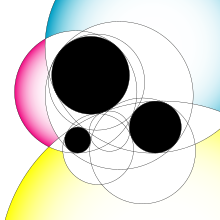Problem Apoloniusza
Problem Apoloniusza – problem matematyczny polegający na stworzeniu okręgu stycznego do trzech innych okręgów (Rys. 1). Apoloniusz z Pergi przedstawił i rozwiązał ten problem w swojej pracy Styczności (stgr. Ἐπαφαί, Epaphaí); praca ta zaginęła, jednak raport na temat jej wyników, który wykonał Pappus z Aleksandrii, przetrwał. Dla dowolnych trzech okręgów można stworzyć 8 różnych okręgów, które będą do nich styczne (Rys. 2).
Rozwiązania problemu
Istnieje wiele różnych metod rozwiązania tego problemu. W XVI w., Adriaan van Roomen rozwiązał ten problem korzystając z przecinających się hiperboli, jednak ta metoda nie korzysta jedynie z konstrukcji klasycznych. François Viète znalazł takie rozwiązanie problemu korzystając z ograniczania możliwości: każdy z trzech okręgów może być zmniejszony do 0 stopni (punktu) lub powiększony do nieskończonej ilości stopni (prostej). Skomplikowane metody rozwiązania problemu zaproponowali także René Descartes i księżniczka czeska Elżbieta[1].
Później, matematycy zdefiniowali metody algebraiczne, które umożliwiły zdefiniowanie problemu za pomocą równań algebraicznych.
Typy Problemu Apoloniusza
Ogólnie rzecz biorąc, Problem Apoloniusza można zdefiniować jako problem narysowania okręgu stycznego do trzech danych elementów. W konsekwencji daje to 10 różnych typów tegoż problemu, przedstawionych poniżej:
Przypisy
- ↑ Shapiro 2013 ↓, 3.3.
Bibliografia
- Lisa Shapiro, Elisabeth, Princess of Bohemia, Edward N. Zalta (red.), [w:] Stanford Encyclopedia of Philosophy [online], Winter 2017 Edition, Metaphysics Research Lab, Stanford University, 20 sierpnia 2013, 3.3, ISSN 095-5054 [dostęp 2018-01-30] [zarchiwizowane z adresu 2017-12-21] (ang.).
Literatura
- Boyd DW. The osculatory packing of a three-dimensional sphere. „Canadian J. Math.”, s. 303–322, 1973.
- Célèbres problèmes mathématiques. Paryż: Albin Michel, 1949, s. 219–226. OCLC 61042170.
- Apollonii de Tactionibus, quae supersunt, ac maxime lemmata Pappi, in hos libros Graece nunc primum edita, e codicibus manuscriptis, cum Vietae librorum Apollonii restitutione, adjectis observationibus, computationibus, ac problematis Apolloniani historia. Gothae: Ettinger, 1795.
- Gisch D, Ribando JM. Apollonius’ Problem: A Study of Solutions and Their Connections. „American Journal of Undergraduate Research”, s. 15–25, 2004.
- Pappus d'Alexandrie: La collection mathématique. Paryż: 1933. OCLC 67245614.
- Über die Entwicklung der Elementargeometrie im XIX. Jahrhundert. Berlin: Teubner, 1906, s. 97–105.
- The Penguin Dictionary of Curious and Interesting Geometry. Nowy Jork: Penguin Books, 1991, s. 3–5. ISBN 0-14-011813-6.
Linki zewnętrzne
- Eric W. Weisstein, Apollonius' Problem, [w:] MathWorld [online], Wolfram Research [dostęp 2020-12-12] (ang.).
Media użyte na tej stronie
Autor: WillowW, Licencja: CC BY-SA 3.0
Alternative version of Image:Apollonius_CLL.svg, with the given circle and lines shown in black, as suggested by Jakob Scholbach. :)
Typical solution of Apollonius' problem, which is to find a circle (pink) tangent to three given circles (black).
Autor: Melchoir, Licencja: CC BY-SA 3.0
The eight solutions of Apollonius' problem. The three given circles are shown in black. The eight solution circles are shown as four pairs (blue, magenta, yellow and grey). In each pair, one solution circle encloses the given circles that are excluded by the other solution, and vice versa. For example, the larger blue solution encloses the two larger given circles, but excludes the smallest; the smaller blue solution does the reverse.
Autor: WillowW, Licencja: CC BY-SA 3.0
Alternative version of Image:Apollonius_PPP.svg, with the given points shown in black, as suggested by Jakob Scholbach. :)
Autor: WillowW, Licencja: CC BY-SA 3.0
Alternative version of Image:Apollonius_LLP.svg, with the given lines and point shown in black, as suggested by Jakob Scholbach. :)
Autor: WillowW, Licencja: CC BY-SA 3.0
Alternative version of Image:Apollonius_LLL.svg, with the given lines shown in black, as suggested by Jakob Scholbach. :)
Autor: WillowW, Licencja: CC BY-SA 3.0
Alternative version of Image:Apollonius_CPP.svg, with the given circle and points shown in black, as suggested by Jakob Scholbach. :)
Autor: WillowW, Licencja: CC BY-SA 3.0
Alternative version of Image:Apollonius_CCL.svg, with the given lines and point shown in black, as suggested by Jakob Scholbach. :)
Autor: WillowW, Licencja: CC BY-SA 3.0
Alternative version of Image:Apollonius_CCC.svg, with the given lines and point shown in black, as suggested by Jakob Scholbach. :)
Autor: WillowW, Licencja: CC BY-SA 3.0
Alternative version of Image:Apollonius_CCP.svg, with the given circles and point shown in black, as suggested by Jakob Scholbach. :)
Autor: WillowW, Licencja: CC BY-SA 3.0
Alternative version of Image:Apollonius_CLP.svg, with the given circle, line and point shown in black, as suggested by Jakob Scholbach. :)
Autor: WillowW, Licencja: CC BY-SA 3.0
Alternative version of Image:Apollonius_LPP.svg, with the given line and points shown in black, as suggested by Jakob Scholbach. :)






















